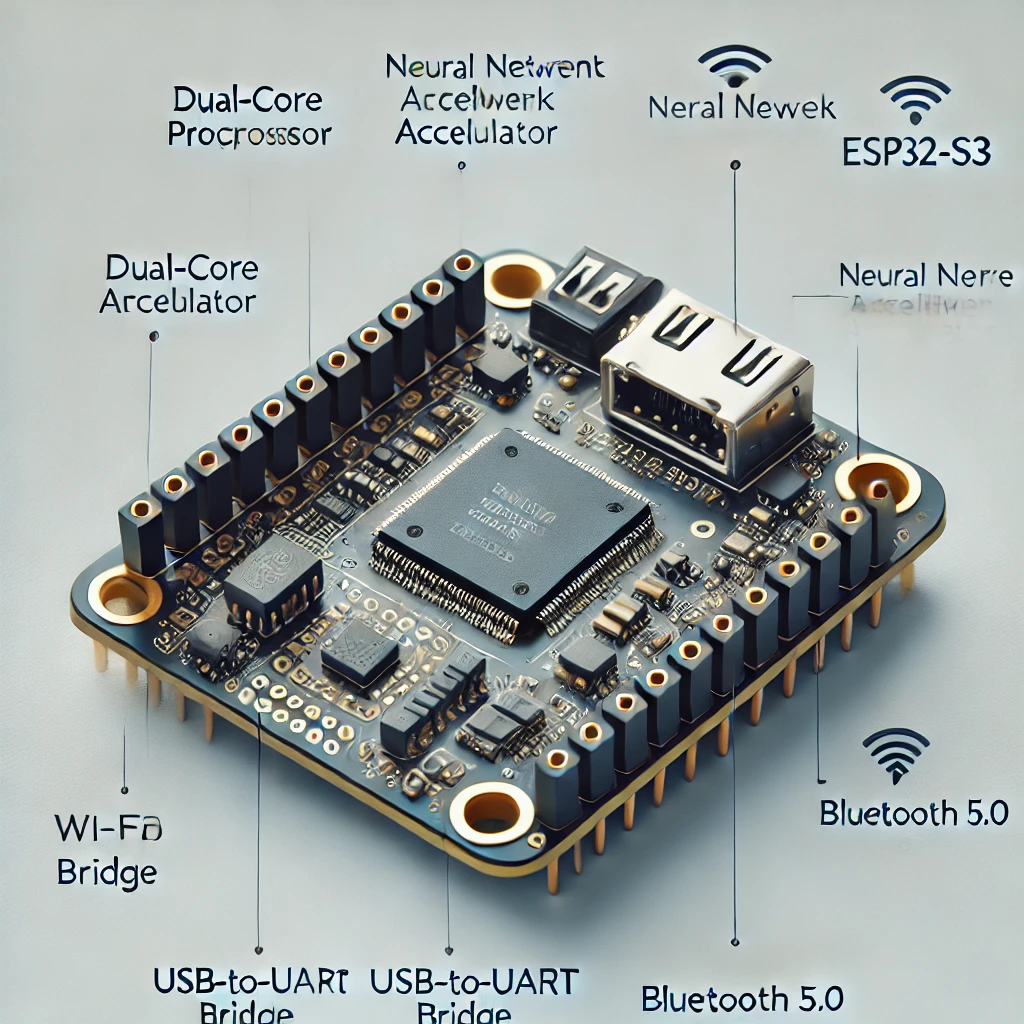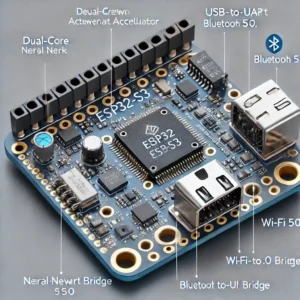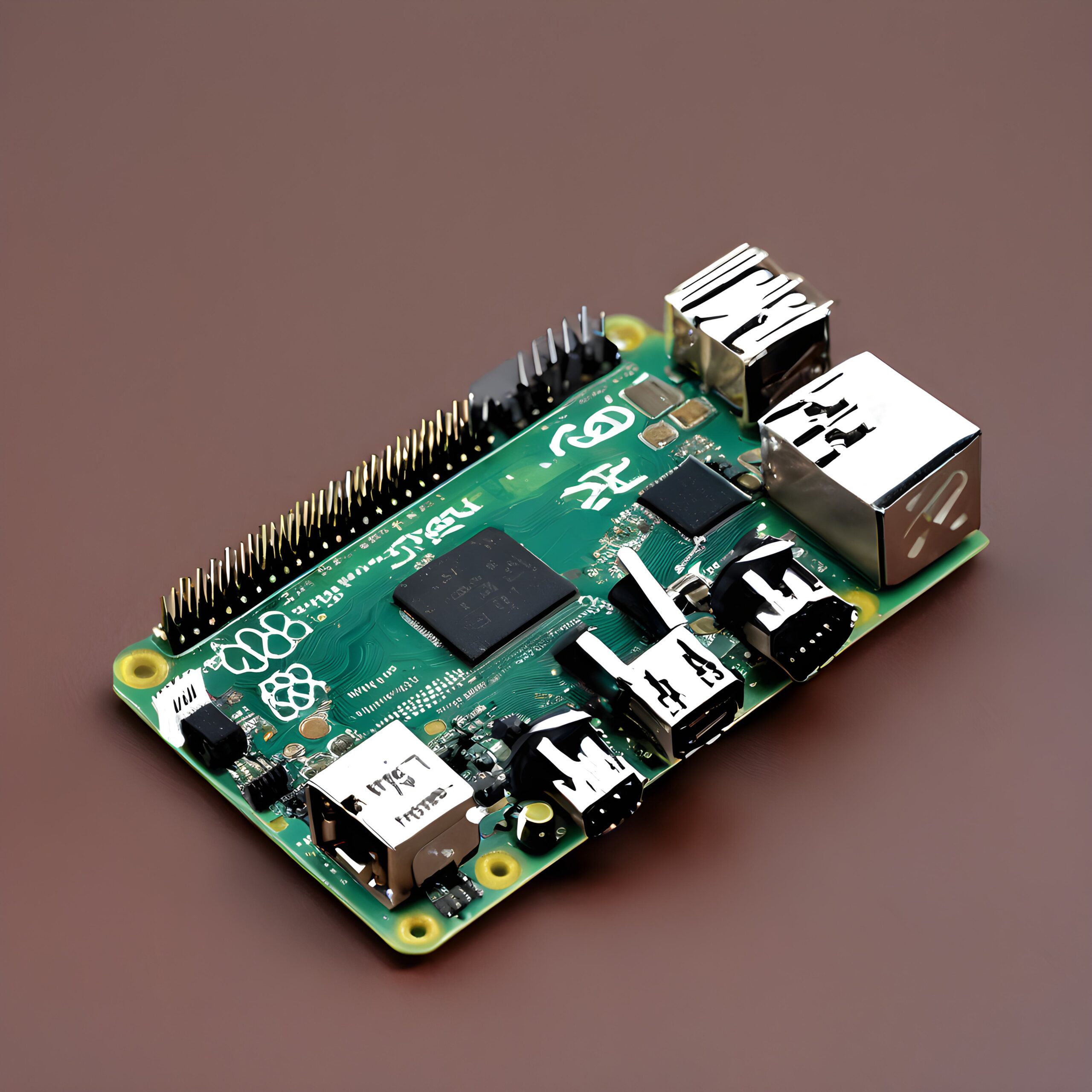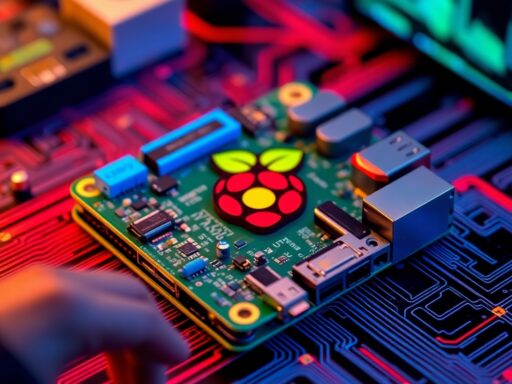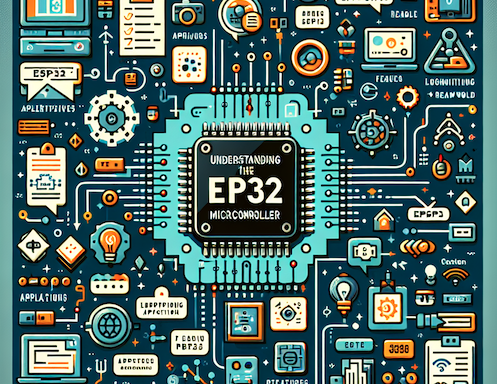The ESP32-S3 is a cutting-edge microcontroller designed for AI applications, IoT, and edge computing. This article delves into the key features, capabilities, and real-world applications of the ESP32-S3, highlighting its Neural Network Accelerator, dual-core processor, advanced security, and energy-efficient design.
We explore its support for Wi-Fi and Bluetooth 5.0, development tools like Arduino IDE and ESP-IDF, and its suitability for both hobbyists and professionals. With its ability to run machine learning models directly on the device, the ESP32-S3 is a versatile platform for the next generation of connected, intelligent devices. In addition, a comprehensive FAQ section answers key questions to help you get the most out of the ESP32-S3.
The ESP32-S3 is a cutting-edge microcontroller designed by Espressif that offers a perfect balance of processing power, energy efficiency, and connectivity. It is one of the most versatile and powerful microcontrollers, particularly for edge AI and IoT applications. This article will explore its key features, applications, and development potential, providing a comprehensive understanding of what makes the ESP32-S3 a top choice for hobbyists and professionals.
High-Performance Dual-Core Processor
At the heart of the ESP32-S3 is its dual-core 240 MHz Xtensa LX7 processor, a significant upgrade from its predecessors. This processor is designed for maximum performance while maintaining low power consumption. It is an excellent choice for real-time applications and data-heavy tasks like machine learning and AI inference at the edge.
In-depth Features:
- Dual-Core Architecture: The ESP32-S3’s dual-core processors ensure that multiple tasks can be executed simultaneously without affecting performance. This is particularly useful for real-time data processing applications, like monitoring systems, automated systems, or robotics. While one core can handle time-critical tasks, the other can manage secondary operations like data storage or network communication.
- Advanced Digital Signal Processing (DSP): The processor is optimized for DSP applications, which are critical for audio and video processing, machine learning, and sensor data analytics. With DSP, the ESP32-S3 can more efficiently process complex signals like audio or sensor data than traditional processors.
- Low Latency and Multitasking: The ESP32-S3 offers low-latency processing, enabling real-time responsiveness, an essential factor in applications such as speech recognition, gesture control, and edge computing. Its multitasking capabilities make it suitable for applications where multiple functions must be performed concurrently without degradation.
These features collectively make the ESP32-S3 ideal for edge computing and real-time AI applications, setting it apart from other microcontrollers in its class.
AI and Machine Learning Optimizations
One of the standout features of the ESP32-S3 is its Neural Network Accelerator. This hardware-based accelerator is specifically designed to run machine learning models on the device, thereby reducing the need for cloud computing and minimizing latency. By integrating AI capabilities directly on the microcontroller, the ESP32-S3 makes AI more accessible and efficient for embedded systems.
Key Insights on AI Capabilities:
- TensorFlow Lite Support: The ESP32-S3 is fully compatible with TensorFlow Lite, an open-source deep learning framework that allows developers to build and deploy machine learning models. TensorFlow Lite is designed for edge devices, providing the tools necessary to run AI models on low-power devices like the ESP32-S3.
- On-device Machine Learning: This capability significantly reduces the reliance on cloud-based AI services, enabling more autonomous systems and improving response times. For example, the ESP32-S3 can run models for speech recognition, object detection, and predictive maintenance without a constant internet connection.
- Optimized for Edge AI: The ESP32-S3 is optimized for edge AI, which involves running AI algorithms closer to where data is generated, thus reducing data transfer to the cloud and making systems faster, more secure, and more energy-efficient. Its ability to process sensor data, perform real-time analysis, and act based on that analysis on the spot makes it a game-changer in IoT and edge computing.
By providing on-device AI capabilities, the ESP32-S3 lowers both the cost and complexity of AI-powered IoT systems, making AI a practical solution for a broader range of devices.
Connectivity: Dual-WiFi and Bluetooth
Connectivity is essential for modern embedded systems, and the ESP32-S3 excels in this area with Wi-Fi and Bluetooth 5.0 support support. This makes it an ideal choice for building IoT devices that require high-speed data transmission and low-latency communication.
Expanded Connectivity Features:
- Dual-Band Wi-Fi (2.4 GHz and 5 GHz): The dual-band Wi-Fi support allows the ESP32-S3 to operate efficiently in crowded and less congested frequency bands. This flexibility is crucial for applications like smart homes, industrial automation, and large-scale IoT networks, where high bandwidth is required to transmit data without interference.
- Bluetooth 5.0: The Bluetooth 5.0 support ensures that devices communicate seamlessly with Bluetooth-enabled peripherals like smartphones, wearables, and sensors. Bluetooth 5.0 offers a broader range, faster speeds, and lower power consumption, perfect for long-range communication in IoT systems.
- USB OTG: The ESP32-S3 supports USB On-the-Go (OTG), enabling it to act as both a USB host and a device. This is particularly useful in applications where peripheral devices like keyboards, cameras, and storage must be connected to the microcontroller for additional functionality. The USB-to-UART bridge feature further simplifies communication with USB-based devices, making integration easier for developers.
The ESP32-S3’s comprehensive connectivity suite ensures that it can support a wide range of communication standards, allowing developers to create connected devices across various use cases, from healthcare to smart homes.
Energy Efficiency for IoT Applications
Energy efficiency is a crucial factor in the world of IoT, especially with battery-powered devices. The ESP32-S3 is engineered to be extremely power-efficient, offering several low-power states to extend battery life.
Low Power Features:
- Deep Sleep Mode: The deep sleep mode enables the ESP32-S3 to consume less than 10 µA of current when not actively performing tasks. This is particularly important for battery-powered devices, such as wearables and remote sensors, where long battery life is essential.
- Dynamic Voltage and Frequency Scaling (DVFS): The ESP32-S3 includes DVFS technology, which dynamically adjusts the voltage and frequency to balance between power consumption and performance. This allows the microcontroller to save power when full performance is not necessary.
- RTC Operation: The real-time clock (RTC) continues to function even during deep sleep, which is essential for scheduling tasks, collecting sensor data at specific intervals, or waking up the system at predefined times without needing external intervention.
By integrating these low-power features, the ESP32-S3 can support energy-hungry applications without compromising battery life, making it an ideal candidate for IoT systems that require long-term deployment.
Security Features
Security is a growing concern in the IoT space, and the ESP32-S3 addresses this with a range of advanced features designed to protect both the device’s hardware and software.
Security Capabilities:
- Secure Boot: The secure boot process ensures that the device can only run authenticated firmware, preventing unauthorized code from being executed.
- Flash Encryption: With flash encryption, data stored on the ESP32-S3 is encrypted, making it unreadable to unauthorized parties, even if the device is physically compromised.
- Cryptographic Hardware Accelerators: The microcontroller includes hardware acceleration for common cryptographic algorithms such as AES, RSA, and SHA. This ensures fast, secure communication without significant resources, making it ideal for secure IoT applications transmitting sensitive data.
With these advanced security features, the ESP32-S3 ensures that devices are protected from physical and cyber threats, which is especially crucial for healthcare, finance, and industrial automation applications applications.
Developer-Friendly Ecosystem
Espressif has created an ecosystem around the ESP32-S3 designed to make development as easy and efficient as possible. From software libraries to community support, developers can easily start their projects and access resources that can help them through every stage of development.
Developer Resources:
- Arduino IDE Support: The ESP32-S3 is compatible with the Arduino IDE, which makes it an excellent choice for beginners. The extensive libraries and examples available in the Arduino ecosystem allow developers to prototype and deploy projects quickly.
- ESP-IDF: For more advanced users, the Espressif IoT Development Framework (ESP-IDF) provides low-level control and access to all the features of the ESP32-S3. This framework includes Wi-Fi, Bluetooth, and security APIs, giving developers full control over their applications.
- Espressif Community: The large and active community around the ESP32-S3 ensures developers can find support, share ideas, and access tutorials and guides. This vibrant community helps beginners and experienced developers troubleshoot issues and accelerate the development process.
These tools make the ESP32-S3 accessible to hobbyists and professionals, enabling developers to create IoT applications easily.
The ESP32-S3 and Its Transformative Potential
The ESP32-S3 is an impressive microcontroller that stands out in IoT, edge computing, and AI applications. With its dual-core processor, AI and machine learning optimizations, and comprehensive connectivity options, it’s clear that this chip has been designed with future-facing applications in mind. Whether you’re building energy-efficient sensors, wearable devices, or autonomous edge AI systems, the ESP32-S3 provides the performance and flexibility necessary for various use cases.
Its integration of low-power features, including deep sleep modes and hardware-based cryptographic accelerators, makes it particularly well-suited for battery-powered applications, while Wi-Fi, Bluetooth 5.0, and USB OTG ensure that devices can communicate seamlessly in modern, connected environments.
Moreover, the developer-friendly ecosystem, including support for Arduino IDE, ESP-IDF, and a large community, further ensures that both hobbyists and professionals can easily adopt the ESP32-S3. By integrating advanced features like machine learning, AI inference at the edge, and robust security mechanisms, the ESP32-S3 is not only ready to handle the IoT demands of today. Still, it is also fully equipped to support the next generation of connected intelligent devices.
As we continue to push the boundaries of what embedded systems can do, the ESP32-S3 is poised to play a pivotal role in shaping the future of IoT, AI, and machine learning. Whether you’re developing smart homes, autonomous systems, or industrial IoT devices, the ESP32-S3 provides an innovative, versatile, and powerful platform to bring your ideas to life.
FAQ
1. What are the main features of the ESP32-S3?
The ESP32-S3 is a powerful microcontroller with a dual-core 240 MHz Xtensa LX7 processor, a Neural Network Accelerator for AI applications, dual-band Wi-Fi, Bluetooth 5.0, and advanced security features such as secure boot and flash encryption.
2. Can I run machine learning models on the ESP32-S3?
Yes, the ESP32-S3 can run machine learning models thanks to its Neural Network Accelerator. It is optimized for TensorFlow Lite, enabling on-device machine learning tasks like image classification and speech recognition.
3. How does the ESP32-S3 handle energy efficiency?
The ESP32-S3 is designed with several energy-saving features, including deep sleep modes that consume less than 10 µA of current. It also supports Dynamic Voltage and Frequency Scaling (DVFS), allowing it to adjust power consumption according to workload demands.
4. What is the Neural Network Accelerator in the ESP32-S3?
The Neural Network Accelerator is a hardware module designed to accelerate machine learning tasks directly on the chip. It supports popular frameworks like TensorFlow Lite and enables faster, more efficient AI inference at the edge.
5. What kind of security features does the ESP32-S3 have?
The ESP32-S3 includes secure boot, flash encryption, and hardware accelerators for cryptographic algorithms such as AES and RSA. These features ensuresafee storage, communication, and system integrity.
6. What is the ESP32-S3’s Wi-Fi and Bluetooth capability?
The ESP32-S3 supports dual-band Wi-Fi (2.4 GHz and 5 GHz) for fast, reliable internet connectivity. It also supports Bluetooth 5.0, offering enhanced range, speed, and low energy consumption, which is ideal for IoT applications.
7. What types of IoT applications are ideal for the ESP32-S3?
The ESP32-S3 is perfect for edge AI devices, smart home systems, wearable devices, industrial IoT sensors, andapplicationsn requiring low-latency communication and on-device machine learning.
8. How can I develop with the ESP32-S3?
The ESP32-S3 supports development with the Arduino IDE, ESP-IDF, and other popular platforms. These tools provide access to various libraries and frameworks to help developers get started quickly.
9. Can the ESP32-S3 handle real-time processing?
Yes, theESP32-S3’s dual-core architecture and low-latency performance make it highly capable of handling real-time data processing, ideal for applications such as speech recognition, gesture control, and sensor data analysis.
10. Is the ESP32-S3 suitable for battery-powered applications?
Yes, the ESP32-S3 is optimized for low power consumption. With deep sleep modes and dynamic voltage scaling, it can operate for extended periods in battery-powered applications, such as wearables and remote sensors.
11. How does the ESP32-S3 compare to other microcontrollers?
Compared to other microcontrollers, the ESP32-S3 offers superior performance with its dual-core processor, AI capabilities, and advanced security features. It also provides excellent Wi-Fi and Bluetooth connectivity, making it a better choice for IoT and AI-powered applications.
12. How do I integrate AI models into my ESP32-S3 project?Using frameworks like TensorFlow Lite, youu can integrate AI models into your ESP32-S3 projece. The Neural Network Acceleratorspeedsd up the inference process, allowing real-time decision-making for tasks like image classification or voice commands.
13. What are the potential limitations of the ESP32-S3?
While the ESP32-S3 is powerful, its onboard memory (RAM and flash) may limit the size of complex AI models. However, this limitation is easily manageable for most IoT and edge AI tasks, especially when using optimized machine learning models.
14. What development tools are available for the ESP32-S3?
The ESP32-S3 supports development with tools like Arduino IDE, ESP-IDF, PlatformIO, and MicroPython, ensuring flexibility for developers across different skill levels and programming languages.
15. Is there community support for ESP32-S3 development?
Yes, the ESP32-S3 has a large and active community. Developers can access forums, online tutorials, documentation, and troubleshooting guides from Espressif and community-driven resources, making developing and debugging projects easier.

